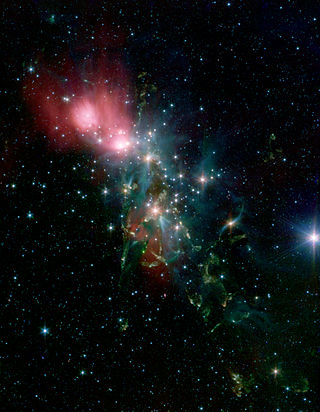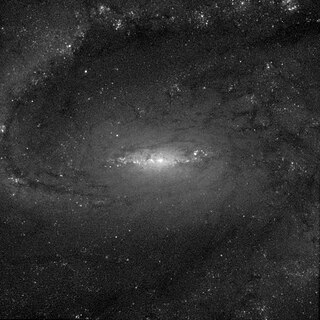
The Eskimo Nebula, also known as the Clown-faced Nebula, Lion Nebula, or Caldwell 39, is a bipolar double-shell planetary nebula (PN). It was discovered by astronomer William Herschel in 1787. The formation resembles a person's head surrounded by a parka hood. It is surrounded by gas that composed the outer layers of a Sun-like star. The visible inner filaments are ejected by a strong wind of particles from the central star. The outer disk contains unusual, light-year-long filaments.

The Saturn Nebula is a planetary nebula in the constellation Aquarius. It appears as a greenish-yellowish hue in a small amateur telescope. It was discovered by William Herschel on September 7, 1782, using a telescope of his own design in the garden at his home in Datchet, England, and was one of his earliest discoveries in his sky survey. The nebula was originally a low-mass star that ejected its layers into space, forming the nebula. The central star is now a bright white dwarf star of apparent magnitude 11.5. The Saturn Nebula gets its name from its superficial resemblance to the planet Saturn with its rings nearly edge-on to the observer. It was so named by Lord Rosse in the 1840s, when telescopes had improved to the point that its Saturn-like shape could be discerned. William Henry Smyth said that the Saturn Nebula was one of Struve's nine "Rare Celestial Objects".

NGC 7027, also known as the Jewel Bug Nebula or the Magic Carpet Nebula, is a very young and dense planetary nebula located around 3,000 light-years from Earth in the constellation Cygnus. Discovered in 1878 by Édouard Stephan using the 800 mm (31 in) reflector at Marseille Observatory, it is one of the smallest planetary nebulae and by far the most extensively studied.

NGC 3132 is a bright and extensively studied planetary nebula in the constellation Vela. Its distance from Earth is estimated at 613 pc or 2,000 light-years.

NGC 1333 is a reflection nebula located in the northern constellation Perseus, positioned next to the southern constellation border with Taurus and Aries. It was first discovered by German astronomer Eduard Schönfeld in 1855. The nebula is visible as a hazy patch in a small telescope, while a larger aperture will show a pair of dark nebulae designated Barnard 1 and Barnard 2. It is associated with a dark cloud L1450. Estimates of the distance to this nebula range from 980–1,140 ly (300–350 pc).

The Little Gem Nebula or NGC 6818 is a planetary nebula located in the constellation of Sagittarius. It has magnitude 10 and oval diameter of 15 to 22 arcseconds with a 15th magnitude central star.

NGC 6559 is a star-forming region located at a distance of about 5000 light-years from Earth, in the constellation of Sagittarius, showing both emission (red) and reflection (bluish) regions.

NGC 6153 is a planetary nebula in the constellation Scorpius. It was discovered in 1883 by Ralph Copeland.

NGC 6221 is a barred spiral galaxy located in the constellation Ara. In de Vaucouleurs' galaxy morphological classification scheme, it is classified as SB(s)bc and was discovered by British astronomer John Herschel on 3 May 1835. NGC 6221 is located at about 69 million light years from Earth.

NGC 6300 is a barred Seyfert spiral galaxy located in the constellation Ara. It is classified as SB(rs)b in the galaxy morphological classification scheme and was discovered by the Scottish astronomer James Dunlop on 30 June 1826. NGC 6300 is located at about 51 million light years away from Earth. It is suspected that a massive black hole may be at its center, pulling all the nearby objects into it. In turn, it emits large amounts of X-rays.

NGC 6309, also known as the Box Nebula, is a planetary nebula located in the constellation Ophiuchus. It was discovered by the German astronomer Wilhelm Tempel in 1876. It has a luminosity of about 1800 times that of the Sun. The distance to this nebula is not well known, but it is assumed to be about 6,500 light-years or 2,000 parsecs.

NGC 6328 is an intermediate spiral galaxy located in the constellation Ara. It is classified as SAB(s)ab in the galaxy morphological classification scheme and was discovered by the British astronomer John Herschel on 2 May 1835. NGC 6328 is located at about 199 million light years away from Earth.

NGC 1858 is a bright, large, irregular open cluster and emission nebula. It is found in the Dorado constellation. It is located in the Large Magellanic Cloud. It was first discovered by James Dunlop on August 3, 1826, and was first recorded as Dunlop 120. John Herschel recorded it on November 2, 1834. However, at the time, he did not associate it with Dunlop 120. Astronomers have now realised that Dunlop 120 and NGC 1858 are the same object.

NGC 1255 is a barred spiral galaxy approximately 69 million light-years away from Earth in the constellation of Fornax.

NGC 2064 is a reflection nebula that is located 1600 light years away from earth in the constellation Orion. It was discovered on January 11, 1864 by Heinrich d'Arrest. It is part of a group of nebulae that includes Messier 78, NGC 2071 and NGC 2067. Objects that appear close to NGC 2064 from our perspective include the Spirograph nebula, Horsehead nebula, Flame nebula, Rosette nebula and the Orion nebula. This object has a magnitude of 8.2.

NGC 592 is an H II region type emission nebula located in the Triangulum galaxy (M33) and thus in the constellation of Triangulum. The nebula contains an open cluster of stars and is approximately 2.86 million light-years away from Earth.

NGC 6742 is a planetary nebula in the constellation Draco. NGC 6742 was discovered by German-British astronomer William Herschel in 1788. Very few studies have been carried out on NGC 6742 and the identification of the central star of the nebula by the Kepler Space Telescope is uncertain.

NGC 2792 is a planetary nebula located in the constellation Vela. NGC 2792 was discovered by British astronomer John Herschel in 1835.


















